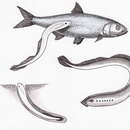Diagnostic Description
provided by Fishbase
Distinguished from other species of this genus by its predatory mode of life. Breeding adults are usually 14-30 cm long. There are 58-70 trunk myomeres. The trunk is not mottled in ammocoetes. The caudal fin is hyaline (Ref. 59043). Adults: 12-30 cm TL. Body wet weight of 48 individuals 14.0-24.1 cm TL, 2.66-21.65 g. Body proportions, as percentage of TL (based on 60-66 specimens measuring 14.0-24.1 cm TL): prebranchial length, 7.8-13.5; branchial length, 8.6-11.4; trunk length, 42.9-52.5; tail length, 25.6-32.3; cloacal slit length, 0.6-1.7; eye length, 1.0-2.1; disc length, 2.8-7.5; prenostril length, 4.1-8.3; snout length, 4.8-9.3; postocular length, 2.2-3.5. Intestine diameter, 0.03- 0.50 cm. The urogenital papilla length, as a percentage of branchial length, in a spawning male measuring 18 cm TL, 16.2. Trunk myomeres, 59-68. Dentition: Most labial teeth are villiform; supraoral lamina, 2 unicuspid teeth; infraoral lamina, 7-12 teeth, the lateralmost sometimes bicuspid while the rest are unicuspid; usually 3 endolaterals on one side (96%), but 4 (3%) and 2 (1%) also found; endolateral formula, typically 1-2-2 (59%) and 2-2-2 (23%), but also 1-2-1 (9%), and rarely 1-1-2, 2-2-1, 2-3-2, 1-2-2-1, 2-2-2-1, 1-2, 1-3-2, 1-3-1; 4-7 rows of anterials; first row of anterials, 6-13 unicuspid teeth; 2-5 rows of exolaterals; 2-4 rows of posterials; first row of posterials, 15-28 unicuspid teeth; transverse lingual lamina, 9-15 unicuspid teeth, the median one enlarged; longitudinal lingual laminae each with 10-17 usually unicuspid teeth, rarely, one may be bicuspid. Velar tentacles, 7-16, with tubercles; dorsal wings consisting of 2-6 tentacles usually present on either side, not reaching the median tentacle. Body coloration (live) gray blue on the head and dorsal aspect, gray towards pink on lateral aspects and white on the ventral aspect. Lateral line neuromasts unpigmented. Caudal fin pigmentation, - (20%), + (4%), ++ (12%), +++ (64%). Caudal fin shape, spade-like. Oral fimbriae, 90-115. Oral papillae, 15-25 (Ref. 89241).
Life Cycle
provided by Fishbase
Ammocoete stage lasts 3.5-4.5 years feeding on detritus and insect larvae. Metamorphosis usually occurs in July - August which lasts 1-5 months wherein feeding starts in the following March. Spawning occurs in spring (April-June) in uppermost reaches of brooks, usually after one year of predatory life (Ref. 59043).
Migration
provided by Fishbase
Potamodromous. Migrating within streams, migratory in rivers, e.g. Saliminus, Moxostoma, Labeo. Migrations should be cyclical and predictable and cover more than 100 km.
Morphology
provided by Fishbase
Dorsal spines (total): 0; Dorsal soft rays (total): 0
Trophic Strategy
provided by Fishbase
Adult lampreys feed on the blood and flesh of both living and dead fish. Migrates upstream to the upper reaches of brooks during spawning time (Ref. 12268). They live 17-21 months. They spawn 2,000 - 3,000 eggs per female in spring and it seems likely that the majority dies afterwards.
- Recorder
- Drina Sta. Iglesia
Biology
provided by Fishbase
Freshwater species, found in brooks and rivers. In Slovakia, it occurs in the submountainous zone at altitudes between 465 and 550 m and in Subcarpathian Ukraine it is found almost exclusively above 250 m (Ref. 89241). Adults inhabit piedmont and montane zones in clear, well oxygenated brooks. Ammocoetes live in detritus-rich sands or clay sediments (Ref. 59043). Ammocoetes feed on detritus and insect larvae; this stage lasts for 3.5-4.5 years in Danube drainage (Ref. 59043), or 4 to over 5 months in European freshwater basins (Ref. 89241). Larvae live 4+ - 5+ years (Ref. 89241). Metamorphosis usually starts in July - August and lasts for 1-5 months. Adults feed on the blood and flesh of both living and dead fish. They migrate upstream to the upper reaches of brooks during spawning time in spring (Ref. 12268, 59043). The adult phase lasts 17-19 months, feeding only during the first year. Adults parasitic/scavenger on various fishes. The spawning period varies with location. Fecundity, 7,500-10,300 eggs/female. Dead and spent adults have been found in April and May in Subcarpathian Ukraine, whereas in Romania, spawning is said to take place from the end of May into June in Iara Brook, Transylvania and between the end of June and the beginning of July in Bistra MÄrului Brook, Banat. In certain regions of Romania, local people consume (presumably adults of) this species and fishermen also use it (presumably the ammocoetes) as live bait. The feeding phase adults inflict serious damage to trout in Romanian hatcheries (Ref.89241).
Importance
provided by Fishbase
fisheries: subsistence fisheries; bait: occasionally
Eudontomyzon danfordi: Brief Summary
provided by wikipedia EN
Eudontomyzon danfordi, the Carpathian brook lamprey or Danube lamprey, is a species of lamprey in the family Petromyzontidae. It is found in Austria, Bosnia and Herzegovina, Bulgaria, Croatia, Czech Republic, Hungary, Moldova, Romania, Serbia, Montenegro, Slovakia, and Ukraine. Unlike other brook lampreys, this fish is parasitic.
- license
- cc-by-sa-3.0
- copyright
- Wikipedia authors and editors

